Loughdan House Culture & Heritage Tours of Historic Sites in Ireland’s Ancient East
Medieval Ireland, Mountains, Valleys, Landscapes and Bogs of Ireland, Folklore, Saints & Scholars of Monastic Ireland, Working Farms and busy Crafts-Shops
Exciting Tours of Discovery into our Cultural Heartland
Loughdan House, Culture and Heritage Tours, in Ireland’s Ancient East offers private escorted tours for groups and individuals including Kilkenny, Kildare, Wicklow, Dublin to Newgrange, Co. Meath. Our unique, diverse and exciting tours include accommodation and food, transport, guide and admissions. Plus huge stress free enjoyment and loads of fun,
Our distinctive themed tours embrace Ireland’s patchwork of picturesque landscapes, magnificent mountains, world famous peatlands, unique culture and ancient heritage spanning 6ooo years.
Loughdan House Culture and Heritage Tours have designed a range of creatively themed tours that will awaken a hidden Ireland stepping off the tourist trail to experience a vacation of a lifetime. We give to you a sense of belonging, an understanding of craftsmanship, beauty and peace by exploring some of the most awe inspiring places in Ireland, we awaken a sense of wonderment and mystery within you. Our Tours offer something completely different, a magical experience you will never forget.
Price for 7 day tour:
€1694, per person sharing
Single occupancy room + €258
What’s included:
- Guided tour and entrance fees where applicable,
- Escort with transport and support each day,
- 6 nights Bed and breakfast in Loughdan 4* Guest House
- Evening Meal and Picnic lunch Daily
- Transport from Dublin city or Airport on arrival to Loughdan House,
- Transport to Dublin City or Airport on morning of departure,
- Detailed notes on each days adventure with your tour pack
Itinerary
Day 1
We meet in your location in Dublin City or Airport, drive to Loughdan via, Luggala and Sally Gap along the old Military Road, in the afternoon a short walk to the lake shore of Loughdan, Wicklow’s largest natural Lake, if time allows we visit Powerscourt Gardens.
Day 2
Tour of Kildare town, St Brigid’s monastery, Cathedral & Round Tower, The Irish National Stud and Japanese Gardens
St Brigid’s Cathedral in Kildare Town was built by the Norman Bishop Ralph of Bristol in 1223. The entire site is steeped in important religious history; it’s believed to be the location at which Saint Brigid, one of Ireland’s patron saints, founded a nunnery in the 5th century.
The present cathedral, which was restored in the 19th century, contains many links to the past, including a 16th-century vault, early Christian and Norman carvings and a High Cross. The Gothic-style architecture reflects the structure’s dual purpose as both a place of defence and of religious worship.
Also on the grounds is a 12th century round tower that extends 33m in height, making it the second highest in Ireland. Constructed from Wicklow granite and local limestone, this historic tower is open to visitors during the summer months. Stunning views can be taken in from the roof, for visitors daring enough to climb that high.
The Irish National Stud
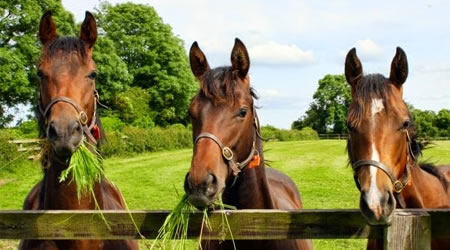 The farm at Tully was purchased from the Fay family in 1900 by Colonel William Hall Walker. Hall Walker became the most successful breeder of the age, enjoying his finest hour when King Edward VII led Minoru, born and raised at Tully, into Epsom’s winners’ enclosure following a famous victory in the 1909 Derby.
The farm at Tully was purchased from the Fay family in 1900 by Colonel William Hall Walker. Hall Walker became the most successful breeder of the age, enjoying his finest hour when King Edward VII led Minoru, born and raised at Tully, into Epsom’s winners’ enclosure following a famous victory in the 1909 Derby.
In 1943, the newly formed Irish Government took over the land and buildings at an agreed valuation. In 1945 the Irish National Stud Company Ltd. was formed and it officially took over the running of the Stud on 31st August, 1946.
Japanese Gardens
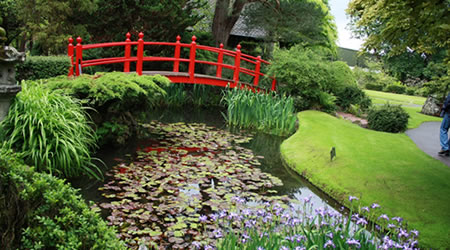 The Japanese Gardens in Kildare town, renowned throughout the world and the finest of their kind in Europe, are far more than simply a treat for the eye. They also provide comfort to the soul, achieving exactly the objective that was set out when the gardens were created between 1906 and 1910. Devised by Colonel William Hall Walker, a wealthy Scotsman from a famous brewing family, the gardens were laid out by Japanese master horticulturist Tassa Eida and his son Minoru. Their aim was, through trees, plants, flowers, lawns, rocks and water, to symbolise the ‘Life of Man’. That plan was executed to perfection and Eida’s legacy is now admired by the 120,000 visitors who soak up the peace of the gardens every year.
The Japanese Gardens in Kildare town, renowned throughout the world and the finest of their kind in Europe, are far more than simply a treat for the eye. They also provide comfort to the soul, achieving exactly the objective that was set out when the gardens were created between 1906 and 1910. Devised by Colonel William Hall Walker, a wealthy Scotsman from a famous brewing family, the gardens were laid out by Japanese master horticulturist Tassa Eida and his son Minoru. Their aim was, through trees, plants, flowers, lawns, rocks and water, to symbolise the ‘Life of Man’. That plan was executed to perfection and Eida’s legacy is now admired by the 120,000 visitors who soak up the peace of the gardens every year.
Very much representative of Japanese gardens from the early 20th century, Eida’s work traces the journey of a soul from oblivion to eternity and portrays the human experience of its embodiment as it journeys by paths of its own choice through life. Birth, childhood, marriage, parenthood, old age, death and the afterlife are all brought to mind as the gardens, a seamless mixture of Eastern and Western cultures, are explored.
Day 3
Wicklow Mountains National Park, Glendalough and Russbourough House
An Introduction To Glendalough, Monastic Settlement
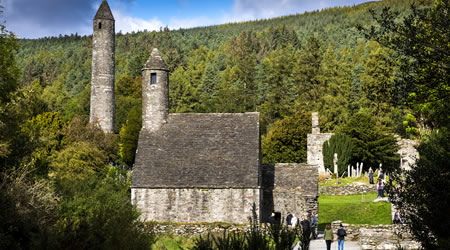 Glendalough, or the Glen of two Lakes, is one of the most important sites of monastic ruins in Ireland. It is also known as the city of the seven Churches. Fourteen centuries have passed since the death of its founder, St. Kevin, when the valley was part of Ireland’s Golden Age.
Glendalough, or the Glen of two Lakes, is one of the most important sites of monastic ruins in Ireland. It is also known as the city of the seven Churches. Fourteen centuries have passed since the death of its founder, St. Kevin, when the valley was part of Ireland’s Golden Age.
The two lakes, which gave the valley its name, came into existence thousands of years ago, after the Ice Age, when great deposits of earth and stone were strewn across the valley in the area where the Round Tower now exists. The mountain streams eventually formed a large lake. The Poullanass river spread alluvial deposits across the centre of the lake and created a divide to form the Upper and Lower Lakes. The Glenalo river flows in from the West into the Upper lake which is the larger and deepest of the two lakes.
Before the arrival of St. Kevin this valley (glen) would have been desolate and remote. It must have been ideal for St Kevin as a retreat and area to be ‘away from it all’. Kevin died in 617 A.D. at the age of 120 years and his name and life’s work is forever entwine with the ruins and the Glendalough Valley. The recorded history of the wooded valley dates from the 6th century – the dawn of Christianity in Ireland. For 500 years it was one of Ireland’s great ecclesiastical foundations and schools of learning. In 1163, Laurence O’Toole, Abbot of Glendalough, who later became Ireland’s first canonised saint, was appointed Archbishop of Dublin and Glendalough.
The monastery continued as an important centre of learning until the early 15th century after which it’s importance declined and fell into decay, a reconstruction program was started in 1878. Further work was carried out in the 20th century Today the valley of Glendalough is extensively wooded and a comprehensive network of walk ways have been completed and continually improved, which provides good access for the visitor and researcher to wonder the valley.
Russborough House & Parklands
 In the afternoon we travel to Russborough is a stunning Palladian mansion overlooking some of the most impressive views in Ireland. Designed in 1741 by Richard Cassels, it took 10 years to build what has been described as one of the most beautiful houses in Ireland. (Bruce Arnold, The Irish Times, 1997). It is home to one of the most impressive private Art collections in Ireland which may be viewed by taking a guided house tour. Sir Alfred and Lady Beit bought Russborough in 1952 to house their impressive art collection. They left this historic mansion, its collections and their fascinating life story to the Irish public in 1978.
In the afternoon we travel to Russborough is a stunning Palladian mansion overlooking some of the most impressive views in Ireland. Designed in 1741 by Richard Cassels, it took 10 years to build what has been described as one of the most beautiful houses in Ireland. (Bruce Arnold, The Irish Times, 1997). It is home to one of the most impressive private Art collections in Ireland which may be viewed by taking a guided house tour. Sir Alfred and Lady Beit bought Russborough in 1952 to house their impressive art collection. They left this historic mansion, its collections and their fascinating life story to the Irish public in 1978.
Day 4
Tour of Dublin including, St. Patrick’s Cathedral and Christ Church Cathedral, Botanical Gardens and Jameson Whiskey Tour
The National Botanic Gardens of Ireland are an oasis of calm and beauty, A premier scientific institution, the gardens contain important collections of plant species and cultivars from all over the world. The National Botanic Gardens in Dublin are located in Glasnevin, just three kilometres from Dublin City Centre, and are famous for the exquisitely restored historic glasshouses. The National Botanic Gardens in Wicklow are located in Killmacurragh, where the milder climate, higher rainfall, and deeper, acidic soils of this historic Wicklow garden, provide a counterpoint to the collections at Glasnevin. The two gardens have been closely associated since 1854.
The National Botanic Gardens of Ireland are operated and managed by the Office of Public Works.
Christ Church Cathedral
Christ Church Cathedral is Dublin’s oldest building, a leading visitor attraction and a place of pilgrimage for almost 1,000 years. Renowned for its beauty, architecture and exquisite floor tiles, it is home to the famous 12th Century crypt, one of the oldest and largest in Britain and Ireland. Perfectly located in the heart of Medieval Dublin, it was founded in 1030 by Sitriuc, King of the Dublin Norsemen and was incorporated into the Irish Church in 1152 and eventually led by the famous Archbishop and patron saint of Dublin, Laurence O’Toole.
Over the years, Christ Church has borne witness to many significant events including the crowning of Lambert Simnel as Edward VI in 1487. Today, it houses the important Treasures of Christ Church which features manuscripts and ancient artefacts as well as a spectacular exhibition of original 16th Century costumes from the historical series ‘The Tudors’. Designed by Emmy award winning designer Joan Bergin, the opulent costumes from the drama have travelled the world including a display in Macy’s New York.
St. Patrick’s Cathedral
One of Dublin’s most historic and famous landmarks, Like Christ Church Cathedral, the building has suffered a rather dramatic history of storm and fire damage and has been altered several times (most questionably in 1864 when the flying buttresses were added, thanks to the neo-Gothic craze that swept the nation).
Jonathan Swift, author of Gulliver’s Travels, was the dean of the cathedral from 1713 to 1745, but after his tenure the cathedral was very neglected until its restoration in the 1860s. Entering the Cathedral from the southwestern porch you come almost immediately, on your right, to the graves of Swift and his long-time companion Esther Johnson, aka Stella. On the wall nearby are Swift’s own (self-praising) Latin epitaphs to the two of them, and a bust of Swift.
The huge, dusty Boyle Monument to the left was erected in 1632 by Richard Boyle, Earl of Cork, and is decorated with numerous painted figures of members of his family. The figure in the centre on the bottom level is the earl’s five-year-old son Robert Boyle (1627–91), who grew up to become a noted scientist. His contributions to physics include Boyle’s Law, which relates to the pressure and volume of gases,
Also like Christ Church, St Patrick’s is a Church of Ireland cathedral – which means that overwhelmingly Catholic, Dublin has two Anglican cathedrals!,
Jameson Distillery Tour, Bow Street
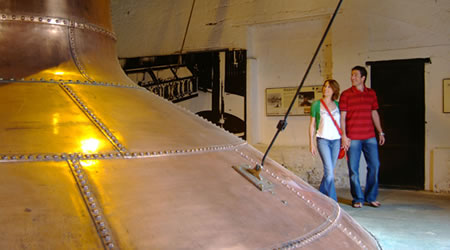 Learn all about the world’s favourite Irish whiskey at the Jameson Distillery Bow Street in Dublin. Whether you love the spirit or are sampling it for the first time, a trip here will give you fantastic insight into the beautiful craft of making whiskey from simple ingredients.
Learn all about the world’s favourite Irish whiskey at the Jameson Distillery Bow Street in Dublin. Whether you love the spirit or are sampling it for the first time, a trip here will give you fantastic insight into the beautiful craft of making whiskey from simple ingredients.
John Jameson, the company’s founder, set up Dublin’s Bow Street distillery as far back as 1780. His passion and legacy are still evident in the brand today. You can learn more on a tour of the distillery. Regular tours take place throughout the year and last for around 50 minutes.
By the time you leave the distillery, you’ll have learned about the history of Irish whiskey and the process of making whiskey, from germination and fermentation to distillation and maturation. Each part of the process is vital to the final taste. The tour also touches on the difference between whiskies from across the globe. You’ll also receive a complimentary Jameson Ginger and Lime to sample before you are done. If you have a Dublin Pass, don’t forget to use it on entry.
If you’re thirsty for more, the Masterclass provides a more in-depth and personal experience, during which you will learn more about the brand and the range. Alternatively, you can take part in the Taste Experience at the bar. This involves enjoying whiskey from a tasting tray while chatting to the knowledgeable bar staff. Whatever experience you choose, it’s hard to leave without a newfound knowledge of and admiration for whiskey. You can enjoy the distillery without joining a tour, too. Indulge in a tasty whiskey-themed lunch, or visit the shop
Day 5
Kilkenny, the Heritage Capital of Ireland
St Canice’s Cathedral and Round Tower The Black Abbey and Kilkenny Castle
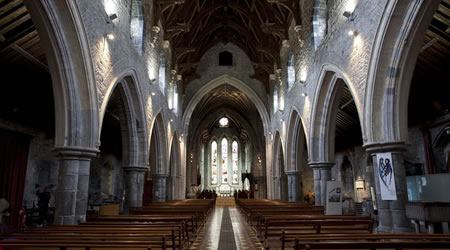 St Canice’s Cathedral and Round Tower are an essential part of the structural heritage in the vibrant medieval city of Kilkenny in the heart of Ireland’s Ancient East This ecclesiastical site was founded in the 6th century and named after St Canice. Cill Channigh is the Gaelic for the Church of Canice, the church that originally stood on the site in the 6th century.
St Canice’s Cathedral and Round Tower are an essential part of the structural heritage in the vibrant medieval city of Kilkenny in the heart of Ireland’s Ancient East This ecclesiastical site was founded in the 6th century and named after St Canice. Cill Channigh is the Gaelic for the Church of Canice, the church that originally stood on the site in the 6th century.
Combining the early Christian settlement, the Round Tower, the Anglo Norman Cathedral and its rich cultural ecclesiastical heritage makes St Canice’s Cathedral and its environs a must to visit while you are in Kilkenny.
Worship has taken place at this site for over 800 years. The Cathedral has wonderful stained glass that includes two windows from the Harry Clarke Studio, Dublin. Local stone masters The O’Tooneys carved some of the tombstones many of which are unique to the Cathedral and Kilkenny. The See Chair of the Bishop of Ossory dating back to 1120 can be seen inside the Cathedral.
The Round Tower is the oldest standing structure in Kilkenny City. Tourists can enjoy climbing the Round Tower capturing great views of the city (weather permitting). St Canice’s Round Tower is one of only two Round Towers that people can climb in Ireland.
At St Canice’s Cathedral worship takes pre-eminence over all other activities. However, this jewel of Gothic Architecture is also used for national concerts and events – for example the Kilkenny Arts Festival held every August – which are in keeping with the environs of the Cathedral.
As a pilgrim or tourist visiting the Cathedral Close you will witness a spiritual, cultural, architectural and archaeological wonder of Kilkenny
Kilkenny Castle
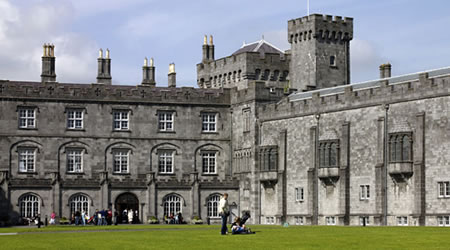 Kilkenny Castle (Irish: Caisleán Chill Chainnigh) is a castle in Kilkenny, Ireland built in 1195 to control a fording-point of the River Nore and the junction of several routeways. It was a symbol of Norman occupation and in its original thirteenth-century condition it would have formed an important element of the defences of the town with four large circular corner towers and a massive ditch, part of which can still be seen today on the Parade.
Kilkenny Castle (Irish: Caisleán Chill Chainnigh) is a castle in Kilkenny, Ireland built in 1195 to control a fording-point of the River Nore and the junction of several routeways. It was a symbol of Norman occupation and in its original thirteenth-century condition it would have formed an important element of the defences of the town with four large circular corner towers and a massive ditch, part of which can still be seen today on the Parade.
The property was transferred to the people of Kilkenny in 1967 for £50[1] and the castle and grounds are now managed by the Office of Public Works. The gardens and parkland adjoining the castle are open to the public. The Parade Tower is a conference venue. Awards and conferring ceremonies of the graduates of “Kilkenny Campus” of National University of Ireland, Maynooth have been held there since 2002.
The Black Abbey
The Black Abbey of Kilkenny, Ireland, is a Catholic priory of the Dominican Order, dedicated to the Holy and Undivided Trinity. Black Abbey was established in 1225 as one of the first houses of the Dominican Order in Ireland.
The history of the Black Abbey is marked by several reversals of fortune under different governments. The priory was founded in 1225 by William Marshal the younger, Earl of Pembroke, who died in 1231.
The name Black Abbey derives from the use of the term “Black Friars” to describe members of the Dominican Order. This in turn derives from the black cappa or cloak which Dominicans wear over their white habit,
When the priory was founded the 13th century, the town of Kilkenny was divided in two parts by the Bregach River. One part was occupied mainly by indigenous Irish and the other by English settlers. The Dominicans established the priory between those two towns and outside the city walls, because they wished to show their independence from either side.
By 1776, the community of the Black Abbey was close to zero, but starting in that year, the Dominicans retook possession of the abbey, first by renting it. In 1816, Black Abbey was restored as a Dominican priory, and the first public mass was held on 25 September 1816.
On Trinity Sunday, 22 May 1864, Black Abbey was reconsecrated by the bishop, and was finally opened again as a house of prayer
Day 6
Today we drive north to Drogheda 30 minutes north of Dublin and visit, Monasterboice, Mellifont Abbey, and Newgrange, a world Heritage site
Monasterboice
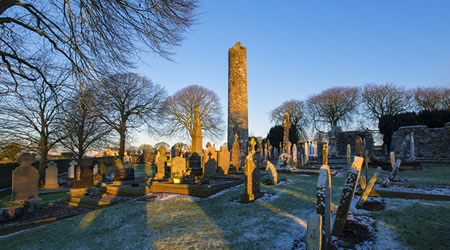 The historic ruins of Monasterboice (Irish: Mainistir Bhuithe) are of an early Christian settlement in County Louth in Ireland, north of Drogheda. It was founded in the late 5th century by Saint Buithe who died around 521, and was an important centre of religion and learning until the founding of nearby Mellifont Abbey in 1142.
The historic ruins of Monasterboice (Irish: Mainistir Bhuithe) are of an early Christian settlement in County Louth in Ireland, north of Drogheda. It was founded in the late 5th century by Saint Buithe who died around 521, and was an important centre of religion and learning until the founding of nearby Mellifont Abbey in 1142.
The site houses two churches built in the 14th century or later and an earlier round tower, but it is most famous for its 10th century high crosses.
In the 5th century, St Buite founded a monastic community near Drogheda in County Louth and today, it is home to an impressive collection of ruins.
On the site, visitors can discover an old graveyard, two churches and a sundial. Another highlights is undoubtedly the well-preserved round tower, which stands at 28m high. There are also two spectacular high crosses: Muirdeach’s Cross and the West Cross, noted as being the tallest in Ireland. The 5.5-metre Muiredach’s High Cross is regarded as the finest high cross in the whole of Ireland. It is named after an abbot, Muiredach mac Domhnaill, who died in 923 and features biblical carvings of both the Old and New Testaments of the Bible. The North and West crosses are also fine examples of this kind of structure, but these have suffered much more from the effects of the weather.
Monasterboice was a thriving centre of religion and learning until 1142, when the Cistercians arrived at the nearby Mellifont Abbey The round tower is about 35-metres tall, and is in very good condition, although it is not possible to go inside. The passage of time has laid down layers of earth so now the doorway is almost at ground level.
Mellifont Abbey, National Monument of Ireland
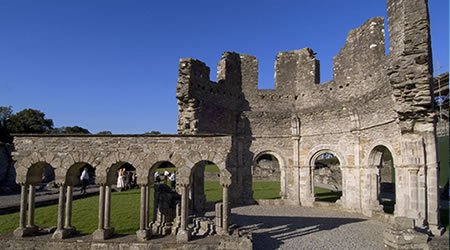 Mellifont Abbey sits on the banks of the River Mattock, some 10 km (6 miles) north-west of Drogheda
Mellifont Abbey sits on the banks of the River Mattock, some 10 km (6 miles) north-west of Drogheda
The abbey was founded in 1142 on the orders of Saint Malachy, Archbishop of Armagh. By 1170, Mellifont had one hundred monks and three hundred lay brothers. The abbey became the model for other Cistercian abbeys built in Ireland, with its formal style of architecture imported from the abbeys of the same order in France; it was the main abbey in Ireland until its dissolution.
Today, the ruined abbey is a National monument of Ireland and accessible to the public. The English language name for the monastery, ‘Mellifont’, comes from the Latin phrase Melli-fons, meaning ‘Font of Honey’.
An important synod was held in Mellifont in 1152 as recorded in the Annals of the Four Masters, which states that the synod was attended by bishops and kings along with the Papal Legate, His Eminence Giovanni Cardinal Paparoni (also known as John Cardinal Paparo; Saint Malachy had died some four years earlier). The consecration of the church took place in 1157 and asserted Church authority by banishing the King of Meath, Donnchadh Ua Maeleachlainn.
Various kings gave donations to assist this foundation: Muirchertach Ua Lochlainn, provincial king of Ulster, gave cattle, some gold and also a local town land, Donnchad Ua Cearbhall, the king of Airgialla (Oriel), who had donated the land, also gave gold, while Derbforgaill, the wife of Tigernan Ua Ruairc gave gold, a chalice and altar cloths.
Newgrange – World Heritage Site
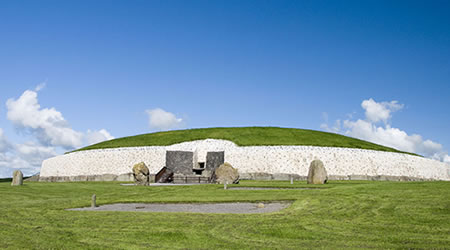 A 5,200 year old passage tomb located in the Boyne Valley in Ireland’s Ancient East.
A 5,200 year old passage tomb located in the Boyne Valley in Ireland’s Ancient East.
Newgrange is a Stone Age (Neolithic) monument in the Boyne Valley, County Meath, it is the jewel in the crown of Ireland’s Ancient East.
Newgrange was constructed about 5,200 years ago (3,200 B.C.) which makes it older than Stonehenge and the Great Pyramids of Giza. Newgrange is a large circular mound 85 meters (93 yards) in diameter and 13.5 meters (15 yards) high with a 19 meter (21 yard) stone passageway and chambers inside. This leads to a cruciform chamber with a corbelled roof. The amount of time and labour invested in construction of Newgrange suggests a well-organized society with specialised groups responsible for different aspects of construction. The mound is ringed by 97 large kerbstones, some of which are engraved with symbols called megalithic art.
Newgrange was built by a farming community that prospered on the rich lands of the Boyne Valley. Knowth and Dowth are similar mounds that together with Newgrange have been designated a World Heritage Site by UNESCO.
Archaeologists classified Newgrange as a passage tomb, however Newgrange is now recognised to be much more than a passage tomb. Ancient Temple is a more fitting classification, a place of astrological, spiritual, religious and ceremonial importance, much as present day cathedrals are places of prestige and worship where dignitaries may be laid to rest.
Newgrange is part of a complex of monuments built along a bend of the River Boyne known collectively as Brú na Bóinne. The other two principal monuments are Knowth (the largest) and Dowth, but throughout the area there are as many as 35 smaller mounds.
Day 7
Today the tour ends and after breakfast we depart Loughdan for your Location in Dublin City or Airport.

